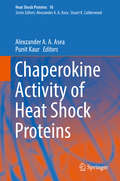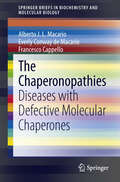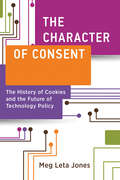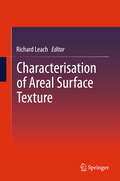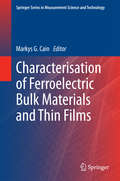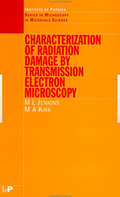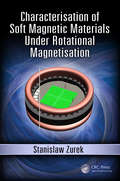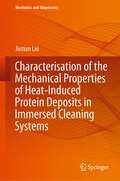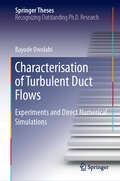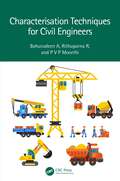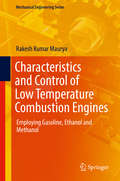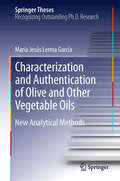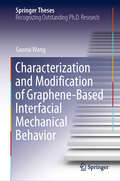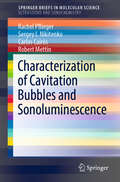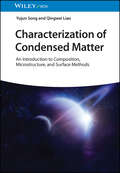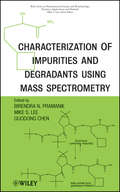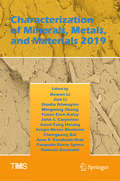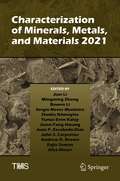- Table View
- List View
Chaperokine Activity of Heat Shock Proteins (Heat Shock Proteins #16)
by Alexzander A. Asea Punit KaurChaperokine, is a term that describes the unique function of extracellular heat shock protein (eHsp) as both chaperone and cytokine. The cellular consequence of binding and signaling of eHsp is the stimulation of a potent and long lasting immune response. eHsp induces a plethora of immune responses including the release of bioactive mediators like cytokines, chemokines, nitric oxide, apotogenic mediator, stimulation of the innate and adaptive immune response, migration and maturation of dendritic cells (DC) and the enhancement of natural killer cell-mediated cellular cytotoxicity.The book Chaperokine Activity of Heat Shock Proteins provides the most comprehensive review on contemporary knowledge on the chaperokine activity of heat shock proteins (HSP) in biology and medicine. Using an integrative approach to understanding the chaperokine activity of HSP, the contributors provide a synopsis of novel mechanisms, signal transduction pathways and how the principles of the chaperokine activity of HSP has been harnessed for therapeutic gain. To enhance the ease of reading and comprehension this book has been subdivided into various section, including; Section I, reviews current progress on our understanding of Immunological and Inflammatory Responses; Section II, evaluates the role of Physiological Responses and Section III, focuses the reader on the Therapeutic Approach. Key basic and clinical research laboratories from major universities, academic medical hospitals, biotechnology and pharmaceutical laboratories around the world have contributed chapters that review present research activity and importantly project the field into the future. The book is a must read for researchers, postdoctoral fellows and graduate students in the fields of Translational Medicine, Clinical Psychologists, Human Physiology, Zoologists, Botanists, Biotechnology, Molecular Medicine, Infectious Diseases Experts, Pathologists, Pharmaceutical Scientists and Researchers involved in Drug Discovery.
Chaperones: Methods and Protocols (Methods in Molecular Biology #1709)
by Stuart K. Calderwood Thomas L. PrinceThe proteome consists of a complex mixture of proteins each of which need to be folded correctly in order to function for the health of the organism, and many of these proteins require molecular chaperones to reach the correct conformation and, in some cases, to remain in a folded form. In Molecular Chaperones: Methods and Protocols, expert researchers address a wide variety of approaches to the study these mechanisms, featuring the workings of heat shock proteins and heat shock transcription factors, in vitro and in vivo. Written in the highly successful Methods in Molecular Biology(tm) series format, chapters features introductions to their respective topics, lists of the necessary materials and reagents, step-by-step, readily reproducible laboratory protocols, and tips on troubleshooting and avoiding known pitfalls. Authoritative and cutting-edge, Molecular Chaperones: Methods and Protocols serves as an ideal guide for all scientists who wish to pursue this vital biological action and its impact on human health and disease.
Chaperones: Methods and Protocols (Methods in Molecular Biology #2693)
by Stuart K. Calderwood Thomas L. PrinceThis second edition volume expands on the previous edition with new discussions on the latest techniques used to study molecular chaperones and the stress response. The chapters in this book cover such as analysis of the initiation and regulation of the stress response; the role of heat shock protein 90 (Hsp90) in gene expression through chromosome-immunoprecipitation; features of chaperone function and biology; the emerging role of the extracellular HSPs; and the use of chaperones as biomarkers. Written in the highly successful Methods in Molecular Biology series format, chapters include introductions to their respective topics, lists of the necessary materials and reagents, step-by-step, readily reproducible laboratory protocols, and tips on troubleshooting and avoiding known pitfalls.Cutting-edge and thorough, Chaperones: Methods and Protocols, Second Edition is a valuable resource for all researchers who want to learn more about this interesting and developing field.
Chaperonin Protocols (Methods in Molecular Biology #140)
by Christine SchneiderChristine Schneider has assembled a unique collection of readily reproducible protocols for the study of chaperonins, intracellular proteins critical to many biological processes. Written by experienced investigators who have successfully honed their methods to a fineness, the protocols focus on the purification of chaperonins from different species along with their corresponding cofactors, and on chaperonin activity assays for in vivo as well as in vitro work. Many activity assays are given for GroEL, which can also be applied to mitochondrial Hsp60. There are also assays for the eukaryotic chaperonin TRiC and handy methods-for example, one for preparing labeled probes-that can be used for various purposes and prove helpful in numerous different procedures. Informative and highly practical, Chaperonin Protocols offers both novice and experienced investigators fast access to today's best and most productive chaperonin methods, all explained in step-by-step detail to ensure robust and reproducible results.
The Chaperonopathies
by Francesco Cappello Everly Conway de Macario Alberto J.L. MacarioThis Brief provides a concise review of chaperonopathies, i.e., diseases in which molecular chaperones play an etiologic-pathogenic role. Introductory chapters deal with the chaperoning system and chaperoning teams and networks, HSP-chaperone subpopulations, the locations and functions of chaperones, and chaperone genes in humans. Other chapters present the chaperonopathies in general, including their molecular features and mechanistic classification into by defect, excess, or mistake. Subsequent chapters discuss the chaperonopathies in more detail, focusing on their distinctive characteristics: primary or secondary; quantitative and/or qualitative; structural and hereditary or acquired; genetic polymorphisms; gene dysregulation; age-related; associated with cancer, chronic inflammatory conditions, and autoimmune diseases. The interconnections between the chaperoning and the immune systems in cancer development, chronic inflammation, autoimmunity, and ageing are outlined, which leads to a discussion on the future prospects of chaperonotherapy. The latter may consist of chaperone gene and protein replacement/supplementation in cases of deficiency and of gene or protein blocking when the chaperone actively promotes disease. The last chapter presents the extracellular chaperones and details on how the chaperone Hsp60 is secreted into the extracellular space and, thus, appears in the blood of cancer patients with potential to participate in carcinogenesis and chronic inflammation and autoimmunity. Chaperones as clinically useful biomarkers are mentioned when pertinent. Likewise, guidelines for clinical evaluation of chaperonopathies and for their histopathological and molecular identification are provided throughout. The book also provides extensive bibliography organized by chapter and topic with comments.
The Character of Cats
by Stephen BudianskyUnlike every other domestic animal, the cat evolved as a solitary animal, not a group-dweller. A cat in a household is almost literally a fish out of water. That cats can nonetheless get along with people and (sometimes) other cats when forced to, is testimony to a remarkable adaptability. But it also makes for an extraordinary range of behaviours. Cats have for years been the subjects of intensive research in the fields of developmental psychology, learning, emotions, brain chemistry, and perception. THE CHARACTER OF CATS is the first popular book to bring this knowledge to bear on the behaviour and nature of cats. Budiansky enables us to see that many of the things that puzzle and at times baffle or even infuriate cat owners have a rational - though often very surprising - explanation in science.
The Character of Consent: The History of Cookies and the Future of Technology Policy (Information Policy)
by Meg Leta JonesThe rich, untold origin story of the ubiquitous web cookie—what&’s wrong with it, why it&’s being retired, and how we can do better.Consent pop-ups continually ask us to download cookies to our computers, but is this all-too-familiar form of privacy protection effective? No, Meg Leta Jones explains in The Character of Consent, rather than promote functionality, privacy, and decentralization, cookie technology has instead made the internet invasive, limited, and clunky. Good thing, then, that the cookie is set for retirement in 2024. In this eye-opening book, Jones tells the little-known story of this broken consent arrangement, tracing it back to the major transnational conflicts around digital consent over the last twenty-five years. What she finds is that the policy controversy is not, in fact, an information crisis—it&’s an identity crisis.Instead of asking how people consent, Jones asks who exactly is consenting and to what. Packed into those cookie pop-ups, she explains, are three distinct areas of law with three different characters who can consent. Within (mainly European) data protection law, the data subject consents. Within communication privacy law, the user consents. And within consumer protection law, the privacy consumer consents. These areas of law have very different histories, motivations, institutional structures, expertise, and strategies, so consent—and the characters who can consent—plays a unique role in those areas of law. The Character of Consent gives each computer character its due, taking us back to their origin stories within the legal history of computing. By doing so, Jones provides alternative ways of understanding the core issues within the consent dilemma. More importantly, she offers bold new approaches to creating and adopting better tech policies in the future.
Characterisation of Areal Surface Texture
by Richard LeachThe function of a component part can be profoundly affected by its surface topography. There are many examples in nature of surfaces that have a well-controlled topography to affect their function. Examples include the hydrophobic effect of the lotus leaf, the reduction of fluid drag due to the riblet structure of shark skin, the directional adhesion of the gecko foot and the angular sensitivity of the multi-faceted fly eye. Surface structuring is also being used extensively in modern manufacturing. In this way many properties can be altered, for example optical, tribological, biological and fluidic. Previously, single line (profile) measurements were adequate to control manufacture of surfaces, but as the need to control the functionality of surfaces increases, there is a growing need for three-dimensional (areal) measurement and characterisation techniques. For this reason there has been considerable research, development and standardisation of areal techniques. This book will present the areal framework that is being adopted by the international community. Whereas previous books have concentrated on the measurement aspects, this book concentrates on the characterisation techniques, i.e. how to interpret the measurement data to give the appropriate (functional) information for a given task. The first part of the book presents the characterisation methods and the second part case studies that highlight the use of areal methods in a broad range of subject areas - from automobile manufacture to archaeology. Contents Introduction to Surface Topography The Areal Field Parameters The Areal Feature Parameters Areal Filtering Methods Areal Form Removal Areal Fractal Methods Choosing the Appropriate Parameter Characterisation of Individual Areal Features Multi-Scale Signature of Surface Topography Correlation of Areal Surface Texture Parameters to Solar Cell EfficiencyCharacterisation of Cylinder Liner Honing Textures for Production Control Characterisation of the Mechanical Bond Strength for Copper on Glass Plating Applications Inspection of Laser Structured Cams and Conrods Road Surfaces
Characterisation of Areal Surface Texture
by Richard LeachThis second edition delves into surface topography, exploring its impact on the functionality of various components. Beginning with an introduction to surface topography in Chapter 1, the subsequent chapters delve into the areal field parameters, feature parameters, filtering methods, and form removal techniques, leading into more specialized topics such as fractal-related multiscale geometric characterization and deep learning-based quantification of surface texture. With a focus on characterizing measurement data to glean functional insights, the book presents a comprehensive framework adopted by the international community. Through a diverse array of case studies spanning automotive applications, road surface engineering, additive manufacturing, and precision machining, readers are offered a holistic understanding of how areal techniques are pivotal in modern manufacturing industries. This edition builds upon the foundation laid by its predecessor, integrating evolving standards and additional case studies to provide an updated and comprehensive resource for modern surface engineering.
Characterisation of Ferroelectric Bulk Materials and Thin Films: Solutions For Metrology (Springer Series in Measurement Science and Technology #2)
by Markys G. CainThis book presents a comprehensive review of the most important methods used in the characterisation of piezoelectric, ferroelectric and pyroelectric materials. It covers techniques for the analysis of bulk materials and thick and thin film materials and devices. There is a growing demand by industry to adapt and integrate piezoelectric materials into ever smaller devices and structures. Such applications development requires the joint development of reliable, robust, accurate and - most importantly - relevant and applicable measurement and characterisation methods and models. In the past few years there has been a rapid development of new techniques to model and measure the variety of properties that are deemed important for applications development engineers and scientists. The book has been written by the leaders in the field and many chapters represent established measurement best practice, with a strong emphasis on application of the methods via worked examples and detailed experimental procedural descriptions. Each chapter contains numerous diagrams, images, and measurement data, all of which are fully referenced and indexed. The book is intended to occupy space in the research or technical lab, and will be a valuable and practical resource for students, materials scientists, engineers, and lab technicians.
Characterisation of Radiation Damage by Transmission Electron Microscopy (Series in Microscopy in Materials Science)
by M.L Jenkins M.A KirkCharacterization of Radiation Damage by Transmission Electron Microscopy details the electron microscopy methods used to investigate complex and fine-scale microstructures, such as those produced by fast-particle irradiation of metals or ion implantation of semiconductors. The book focuses on the methods used to characterize small point-defect clus
Characterisation of Soft Magnetic Materials Under Rotational Magnetisation
by Stanislaw ZurekThe book presents practical aspects related to the measurement of rotational power loss in soft magnetic materials. The book furthermore focuses on practical aspects of performing such measurements, the associated difficulties as well as solutions to the most common problems. Numerous practical aspects, hands-on experience, and most commonly encountered pitfalls are heavily discussed in the book. The text begins with introduction to magnetism, then follows with definitions of measurement methods of rotational power loss from physical viewpoint. Two chapters describe and detail the various sensors which can be employed for such measurements as well as all the aspects of designing, making, and using a magnetising apparatus. A synthesis of the likely optimal design of a magnetising apparatus is also given, preceded with the full reasoning based on all the research carried out to date. <P><P>Characterisation of Soft Magnetic Materials Under Rotational Magnetisation serves as an excellent starting point for any student having to perform magnetic measurements under rotational magnetisation, but also under 1D, 2D or 3D excitation. Because the methods, sensors, and apparatus are extensively discussed it will also be a great reference for more senior researchers and experts in the field. There is a whole chapter devoted to analysis of measurement uncertainty. This subject is rarely published for magnetic measurements, which makes it more difficult for all researchers to understand the concepts and methodology used in uncertainty estimation. This chapter not only introduces the whole subject, but also provides multiple step-by-step examples which can be easily followed, from very simple cases to much more complex ones. All equations are presented with full SI units which greatly helps in practical application of the presented methodology. Each chapter is written in such a way that it can be studied on its own, so that the reader can focus only on the specific aspects, as required.
Characterisation of the Mechanical Properties of Heat-Induced Protein Deposits in Immersed Cleaning Systems (Mechanics and Adaptronics)
by Jintian LiuDuring heat treatment in dairy production, the rapid formation of heat-induced fouling deposits on the plant surface leads to reduced efficiency of heat transfer. Therefore, a regular cleaning process is required to soften the heat-induced protein deposits and then remove them from the plant surface. The mechanical property of the deposits is one of the key issues of the cleaning mechanisms since the non-fractured behaviour dominates the deformation of the fouling layer and the failure behaviour has a great impact on the cohesive removal of fouling deposits. Considering the complicated geometry of fouling deposits and their irregular distribution, indentation experiments were carried out on various kinds of protein deposits. The experimental results reveal the significant influence of the thickness of fouling deposits on their mechanical behaviour and the time-dependent nonlinear behaviour of the deposits.Furthermore, heat-induced whey protein gel was used as the model material for fouling deposits and the non-fractured and fracture behaviour was characterized using compression and wire cutting experiments, respectively. The material parameters identified using the inverse finite element method allow the prediction of fracture behaviour under localized external loads and provide a deeper insight into cohesive removal. To investigate the softening effect during caustic washing, tensile experiments were conducted on chemically treated and untreated whey protein gels. Adequate chemical degradation leads to a softer mechanical response and increased stress relaxation, making whey protein gels more flowable and more resistant to tensile deformation. The experimental results provide useful data on the failure behaviour of chemically treated whey protein gels.
Characterisation of Turbulent Duct Flows: Experiments and Direct Numerical Simulations (Springer Theses)
by Bayode OwolabiThis book presents several new findings in the field of turbulent duct flows, which are important for a range of industrial applications. It presents both high-quality experiments and cutting-edge numerical simulations, providing a level of insight and rigour rarely found in PhD theses. The scientific advancements concern the effect of the Earth’s rotation on large duct flows, the experimental confirmation of marginal turbulence in a pressure-driven square duct flow (previously only predicted in simulations), the identification of similar marginal turbulence in wall-driven flows using simulations (for the first time by any means) and, on a separate but related topic, a comprehensive experimental study on the phenomenon of drag reduction via polymer additives in turbulent duct flows. In turn, the work on drag reduction resulted in a correlation that provides a quantitative prediction of drag reduction based on a single, measurable material property of the polymer solution, regardless of the flow geometry or concentration. The first correlation of its kind, it represents an important advancement from both a scientific and practical perspective.
Characterisation Techniques for Civil Engineers
by Bahurudeen A Rithuparna R P V MoorthiThe primary aim of this book is to provide an understanding of the sophisticated, modern characterisation techniques in the domain of civil engineering. It systematically covers physical, chemical, mineralogical and microstructural characterisation, which is imperative to evaluate the construction materials and their performance. It describes tools such as rheometers, thermogravimetric analysers, scanning electron microscopes, X-ray diffractometers and other miscellaneous methods. In each chapter, a detailed scientific background, instrumentation details, working principles, and applications of a specific technique are provided. Features: • Describes rheological and microstructural characterisation testing. • Discusses sophisticated characterisation techniques for construction materials. • Explains the detailed procedure of sample preparation and testing. • Provides detailed descriptions of different parts of the instruments and their purposes. • Includes questions and answers at the end of each chapter. This book is aimed at graduate students and researchers in civil engineering.
Characteristics and Control of Low Temperature Combustion Engines: Employing Gasoline, Ethanol and Methanol (Mechanical Engineering Series)
by Rakesh Kumar MauryaThis book deals with novel advanced engine combustion technologies having potential of high fuel conversion efficiency along with ultralow NOx and particulate matter (PM) emissions. It offers insight into advanced combustion modes for efficient utilization of gasoline like fuels. Fundamentals of various advanced low temperature combustion (LTC) systems such as HCCI, PCCI, PPC and RCCI engines and their fuel quality requirements are also discussed. Detailed performance, combustion and emissions characteristics of futuristic engine technologies such as PPC and RCCI employing conventional as well as alternative fuels are analyzed and discussed. Special emphasis is placed on soot particle number emission characterization, high load limiting constraints, and fuel effects on combustion characteristics in LTC engines. For closed loop combustion control of LTC engines, sensors, actuators and control strategies are also discussed. The book should prove useful to a broad audience, including graduate students, researchers, and professionals.
The Characteristics Of Aphasia (Brain, Behaviour and Cognition)
by Chris CodeA survey of the main behavioural characteristics or symptoms of aphasia, which presents a series of essays on the history and current developments in this field of neuropsychological research. Contributors discuss recovery, rehabilitation and other contemporary issues.
Characterization and Authentication of Olive and Other Vegetable Oils: New Analytical Methods (Springer Theses)
by María Jesús Lerma GarcíaThis thesis presents new methods for the characterization of vegetable oils, with focus in olive oil, according to geographical and botanical origin, genetic variety and other issues influencing product quality. A wide variety of analytical techniques have been employed, such as various chromatographic techniques (different gas and liquid chromatography methods), an electronic nose, infrared spectroscopy and expert-panel evaluation. Several families of minor compounds, with interest as adulteration markers, have been used for method development, including tocopherols, sterols, phenolics, alcohols, proteins and others. Most methods have been enhanced by the application of multivariate chemometrics. The proposed analytical techniques are of interest to investigate fraudulent actions and practices which are detrimental to product quality.
Characterization and Modification of Graphene-Based Interfacial Mechanical Behavior (Springer Theses)
by Guorui WangThis thesis shares new findings on the interfacial mechanics of graphene-based materials interacting with rigid/soft substrate and with one another. It presents an experimental platform including various loading modes that allow nanoscale deformation of atomically thin films, and a combination of atomic force microscopy (AFM) and Raman spectroscopy that allows both displacement and strain to be precisely measured at microscale. The thesis argues that the rich interfacial behaviors of graphene are dominated by weak van der Waals force, which can be effectively modulated using chemical strategies. The continuum theories are demonstrated to be applicable to nano-mechanics and can be used to predict key parameters such as shear/friction and adhesion. Addressing key interfacial mechanics issues, the findings in thesis not only offer quantitative insights in the novel features of friction and adhesion to be found only at nanoscale, but will also facilitate the deterministic design of high-performance graphene-based nanodevices and nanocomposites.
Characterization of Cavitation Bubbles and Sonoluminescence (SpringerBriefs in Molecular Science)
by Rachel Pflieger Sergey I. Nikitenko Carlos Cairós Robert MettinThis book presents the latest research on fundamental aspects of acoustic bubbles, and in particular on various complementary ways to characterize them. It starts with the dynamics of a single bubble under ultrasound, and then addresses few-bubble systems and the formation and development of bubble structures, before briefly reviewing work on isolated bubbles in standing acoustic waves (bubble traps) and multibubble systems where translation and interaction of bubbles play a major role. Further, it explores the interaction of bubbles with objects, and highlights non-spherical bubble dynamics and the respective collapse geometries. It also discusses the important link between bubble dynamics and energy focusing in the bubble, leading to sonochemistry and sonoluminescence. The second chapter focuses on the emission of light by cavitation bubbles at collapse (sonoluminescence) and on the information that can be gained by sonoluminescence (SL) spectroscopy, e.g. the conditions reached inside the bubbles or the nature of the excited species formed. This chapter also includes a section on the use of SL intensity measurement under pulsed ultrasound as an indirect way to estimate bubble size and size distribution. Lastly, since one very important feature of cavitation systems is their sonochemical activity, the final chapter presents chemical characterizations, the care that should be taken in using them, and the possible visualization of chemical activity. It also explores the links between bubble dynamics, SL spectroscopy and sonochemical activity. This book provides a fundamental basis for other books in the Molecular Science: Ultrasound and Sonochemistry series that are more focused on applied aspects of sonochemistry. A basic knowledge of the characterization of cavitation bubbles is indispensable for the optimization of sonochemical processes, and as such the book is useful for specialists (researchers, engineers, PhD students etc.) working in the wide area of ultrasonic processing.
Characterization of Condensed Matter: An Introduction to Composition, Microstructure, and Surface Methods
by Yujun Song Qingwei LiaoCharacterization of Condensed Matter A comprehensive and accessible introduction to the characterization of condensed materials The characterization of condensed materials is a crucial aspect of materials science. The science underlying this area of research and analysis is interdisciplinary, combining electromagnetic spectroscopy, surface and interface testing methods, physiochemical analysis methods, and more. All of this must be brought to bear in order to understand the relationship between microstructures and larger-scale properties of condensed matter. Characterization of Condensed Matter: An Introduction to Composition, Microstructure, and Surface Methods introduces the technologies involved in the characterization of condensed matter and their many applications. It incorporates more than a decades’ experience in teaching a successful undergraduate course in the subject and emphasizes accessibility and continuously reinforced learning. The result is a survey which promises to equip students with both underlying theory and real experimental instances of condensed matter characterization. Characterization of Condensed Matter readers will also find: Detailed treatment of techniques including electromagnetic spectroscopy, X-ray diffraction, X-ray absorption, electron microscopy, surface and element analysis, and more Incorporation of concrete experimental examples for each technique Exercises at the end of each chapter to facilitate understanding Characterization of Condensed Matter is a useful reference for undergraduates and early-career graduate students seeking a foundation and reference for these essential techniques.
Characterization of Improved Sweet Sorghum Cultivars (SpringerBriefs in Agriculture)
by C. Ganesh Kumar P. Srinivasa RaoA number of driving forces, including the soaring global crude oil prices and environmental concerns in both developed and developing nations has triggered a renewed interest in the recent years on the R&D of biofuel crops. In this regard, many countries across the globe are investing heavily in the bioenergy sector for R&D to increase their energy security and reduce their dependence on imported fossil fuels. Currently, most of the biofuel requirement is met by sugarcane in Brazil and corn in the United States, while biodiesel from rapeseed oil in Europe. Sweet sorghum has been identified as a unique biofuel feedstock in India since it is well adapted to Indian agro-climatic conditions and more importantly it does not jeopardize food security at the cost of fuel. Sweet sorghum [Sorghum bicolor (L.) Moench] is considered as a SMART new generation energy crop as it can accumulate sugars in its stalks similar to sugarcane, but without food¬¬-fuel trade-offs and can be cultivated in almost all temperate and tropical climatic conditions and has many other advantages. The grain can be harvested from the panicles at maturity. There is no single publication detailing the agronomic and biochemical traits of tropical sweet sorghum cultivars and hybrid parents. Hence, an attempt is made in this publication- "Characterization of improved sweet sorghum cultivars" to detail the complete description of cultivars. This book serves as a ready reference on the detailed characterization of different improved sweet sorghum genotypes following the PPVFRA guidelines for the researchers, entrepreneurs, farmers and other stakeholders to identify the available sweet sorghum cultivars and understand their yield potential in tropics.
Characterization of Impurities and Degradants Using Mass Spectrometry
by Mike S. Lee Guodong Chen Birendra PramanikThe book highlights the current practices and future trends in structural characterization of impurities and degradants. It begins with an overview of mass spectrometry techniques as related to the analysis of impurities and degradants, followed by studies involving characterization of process related impurities (including potential genotoxic impurities), and excipient related impurities in formulated products. Both general practitioners in pharmaceutical research and specialists in analytical chemistry field will benefit from this book that will detail step-by-step approaches and new strategies to solve challenging problems related to pharmaceutical research.
Characterization of Minerals, Metals, and Materials 2019 (The Minerals, Metals & Materials Series)
by Bowen Li Jian Li Shadia Ikhmayies Mingming Zhang Yunus Eren Kalay John S. Carpenter Jiann-Yang Hwang Sergio Neves Monteiro Chenguang Bai Juan P. Escobedo-Diaz Pasquale Russo Spena Ramasis GoswamiThis collection gives broad and up-to-date results in the research and development of materials characterization and processing. Topics covered include characterization methods, ferrous materials, non-ferrous materials, minerals, ceramics, polymer and composites, powders, extraction, microstructure, mechanical behavior, processing, corrosion, welding, solidification, magnetic, electronic, environmental, nano-materials, and advanced materials <p><p> The book explores scientific processes to characterize materials using modern technologies, and focuses on the interrelationships and interdependence among processing, structure, properties, and performance of materials.
Characterization of Minerals, Metals, and Materials 2021 (The Minerals, Metals & Materials Series)
by Jian Li Mingming Zhang Bowen Li Sergio Neves Monteiro Shadia Ikhmayies Yunus Eren Kalay Jiann-Yang Hwang Juan P. Escobedo-Diaz John S. Carpenter Andrew D. Brown Rajiv Soman Alex MoserThe collection focuses on the advancements of characterization of minerals, metals, and materials and the applications of characterization results on the processing of these materials. Advanced characterization methods, techniques, and new instruments are emphasized. Areas of interest include, but are not limited to: · Novel methods and techniques for characterizing materials across a spectrum of systems and processes. · Characterization of mechanical, thermal, electrical, optical, dielectric, magnetic, physical, and other properties of materials. · Characterization of structural, morphological, and topographical natures of materials at micro- and nano- scales. · Characterization of extraction and processing including process development and analysis. · Advances in instrument developments for microstructure analysis and performance evaluation of materials, such as computer tomography (CT), X-ray and neutron diffraction, electron microscopy (SEM, FIB, TEM), and spectroscopy (EDS, WDS, EBSD) techniques. · 2D and 3D modelling for materials characterization. The book explores scientific processes to characterize materials using modern technologies, and focuses on the interrelationships and interdependence among processing, structure, properties, and performance of materials.
